Christopher McGuire will inspire your students with stories of his childhood and how he came to realize he could do, “pretty much anything I saw another human doing as long as I was willing to practice.” Rather than merely showing students how they might become musicians, he shows them how, in our country, they can become anything they are willing to work for. He explains to them, “You are here in school to practice becoming the best you that you can be.” McGuire also includes his now famous group chant: “I’m exercising my brain – to have more FREEDOM!” It’s a celebration of the limitless possibilities of growing up and being educated in the United States of America.
Outreach EPK
Outreach EPK
Texas Tapestry
A Musical Journey of the Influences that Created Texas Music.
 The Allegro Guitar Series and other Special Events are just the tip of what we do at the Guitar Society. We also perform outreach programs for children in the Fort Worth ISD and in neighboring school districts throughout Tarrant County. We also provide teaching programs at local schools.
The Allegro Guitar Series and other Special Events are just the tip of what we do at the Guitar Society. We also perform outreach programs for children in the Fort Worth ISD and in neighboring school districts throughout Tarrant County. We also provide teaching programs at local schools.
“Texas Tapestry, a Musical Journey” traces the influences various groups have brought to Texas over a period of 500 years and the influence Texas musicians are now having on the rest of the world. The historical and geographically rich script was co-written by Madeline Myers and Christopher McGuire. Performers in the program are NEA National Heritage Fellowship Honoree, Jim “Texas Shorty” Chancelor; Winfield Banjo Champion, Gerald Jones; jazz and classical bassist George Anderson and FWCGS Artistic Director, Christopher McGuire.
click to download high res photo
Ragas to Riches
The Allegro Guitar Quartet (AGQ) performs “From Ragas to Riches,” a program for elementary school children that traces the plight of the Gitano (or Rom) people from northern India to Spain. The students hear musical influences the Gypsies carried with them and some they picked up along their way from India to Spain. All at once they receive lessons in music, history, various cultures and geography. We introduce students to the sitar, mandolin, hammered and mountain dulcimers, lute, violin and several kinds of guitars. AGQ performers are Gerald Jones, Polly Maynard, Christopher McGuire and Jan Ryberg.
Our story begins in India with young Roshan playing his Sitar for the Great Raja. Roshan is very skilled at the Sitar. By bending and wiggling the notes of his music he can make his pet snake dance, swaying first this way and then that way. But then comes the Raja’s imperial flute player, Akmed, who says, “No, you’re doing it all wrong.” A musical duel ensues. The snake becomes very confused and upset, jumps from his basket and bites the Raja on the nose. Akmed cries, “The Gypsies have killed the Raja.” Roshan and his family must flee very quickly, leaving all their possessions behind, including Roshan’s beloved Sitar. Thus begins a three hundred year odyssey through Europe and Africa that brings the Gypsies, along with the Arabs and Jews, to Spain where they create the exciting music we call Flamenco!
“From Ragas to Riches” introduces students to the sitar, mandolin, hammered and mountain dulcimers, lute, violin and several kinds of guitars.
Allegro Guitar Quartet
Performers:
Gerald Jones, Polly Maynard, Christopher McGuire, Jan Ryberg
Career Day Outreach Programs
Outreach Artist Bios
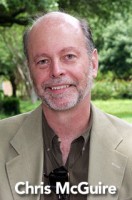 CHRISTOPHER MCGUIRE (guitar) hasperformed hundreds of acclaimed concerts on five continents. He has been invited as a guest with orchestras and prestigious chamber ensembles and composes for his music group, D’Accord. He commands many expressive qualities of the guitar with what one critic called “unselfconscious intensity.” His engaging performance style invites people of all ages to feel they are taking part not just taking a seat. Audiences and critics on four continents fulfill the prediction by Andrés Segovia that “he will be appreciated and applauded everywhere…an artist, sensitive, with perfect technique.” In addition to numerous television and radio appearances he was the subject of a half-hour show on Radio Shanghai of China (estimated audience in thirteen Asian countries: one billion). He recently toured Venezuela performing and giving guitar workshops. Most recently, he has been performing and teaching in Germany. ChristopherMcGuire.com
CHRISTOPHER MCGUIRE (guitar) hasperformed hundreds of acclaimed concerts on five continents. He has been invited as a guest with orchestras and prestigious chamber ensembles and composes for his music group, D’Accord. He commands many expressive qualities of the guitar with what one critic called “unselfconscious intensity.” His engaging performance style invites people of all ages to feel they are taking part not just taking a seat. Audiences and critics on four continents fulfill the prediction by Andrés Segovia that “he will be appreciated and applauded everywhere…an artist, sensitive, with perfect technique.” In addition to numerous television and radio appearances he was the subject of a half-hour show on Radio Shanghai of China (estimated audience in thirteen Asian countries: one billion). He recently toured Venezuela performing and giving guitar workshops. Most recently, he has been performing and teaching in Germany. ChristopherMcGuire.com
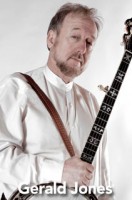 GERALD JONES, (banjo, mandolin, violin, and guitar) is a highly respected performer and studio musician, teacher and Mel Bay author. In addition to his recording work with such notables as Vince Gill, Hank Thompson and Mark O’Connor, he is a two time National Banjo Champion. His repertoire spans four centuries including works by Johann Sebastian Bach and Antonio Vivaldi to Dave Brubeck and the Beatles. A multi-instrumentalist, he plays the guitar, banjo, mandolin, and violin with equal skill and flair. He has performed at the Bass Hall with the Fort Worth Ballet, Guitar on the Go, and his group Sgt. Pepper’s Lonely Bluegrass Band. Mr. Jones conducts Acoustic Music Camp, a three-day event in the DFW area, with world-class instructors for across the nation and students from across the U.S. and several foreign countries. Gerald is also a featured instructor at many camps and workshops from Nashville to Washington State and in between. “Gerald is a unique combination artist and technical expert. His music is soulful and inspiring while his calm analytical mind unravel to most perplexing of technical mysteries. His beautiful music, kooky sense of humor and incredible technical knowledge make him an incredible presence to encounter.” Joe Carr, appeared in Banjo Newsletter. TheGeraldJones.com
GERALD JONES, (banjo, mandolin, violin, and guitar) is a highly respected performer and studio musician, teacher and Mel Bay author. In addition to his recording work with such notables as Vince Gill, Hank Thompson and Mark O’Connor, he is a two time National Banjo Champion. His repertoire spans four centuries including works by Johann Sebastian Bach and Antonio Vivaldi to Dave Brubeck and the Beatles. A multi-instrumentalist, he plays the guitar, banjo, mandolin, and violin with equal skill and flair. He has performed at the Bass Hall with the Fort Worth Ballet, Guitar on the Go, and his group Sgt. Pepper’s Lonely Bluegrass Band. Mr. Jones conducts Acoustic Music Camp, a three-day event in the DFW area, with world-class instructors for across the nation and students from across the U.S. and several foreign countries. Gerald is also a featured instructor at many camps and workshops from Nashville to Washington State and in between. “Gerald is a unique combination artist and technical expert. His music is soulful and inspiring while his calm analytical mind unravel to most perplexing of technical mysteries. His beautiful music, kooky sense of humor and incredible technical knowledge make him an incredible presence to encounter.” Joe Carr, appeared in Banjo Newsletter. TheGeraldJones.com
 GEORGE ANDERSON (bass)has a background in Gospel, Jazz, R & B /Funk, Rock, Country and Classical. He has performed with many renowned artists including concerts with Ray Charles, Tony Bennett, Marvin Hamlisch, Chuck Berry, Joe Williams, The Coasters, Brook Benton, The Fifth Dimension, Doc Severensen, and Phillip Craig and Dean to name a few. As a bassist, he has performed for several television specials including the ABC national TV broadcast of the Texas Sesquicentennial with Johnny Cash, Jimmy Dean, Fred Fender, B.J. Thomas, Jennifer Holliday and the Gatlin Brothers. He also performed with Ella Fitzgerald on the Good Morning America Show. Currently George is recognized as one of the busiest studio session bassists in the Dallas/Fort Worth Metroplex. As a music producer, songwriter, composer/arranger he has worked with pop, rock, jazz and Christian artists. “FACES” is the title of the first solo project that George has released. TheGeorgeAnderson.com
GEORGE ANDERSON (bass)has a background in Gospel, Jazz, R & B /Funk, Rock, Country and Classical. He has performed with many renowned artists including concerts with Ray Charles, Tony Bennett, Marvin Hamlisch, Chuck Berry, Joe Williams, The Coasters, Brook Benton, The Fifth Dimension, Doc Severensen, and Phillip Craig and Dean to name a few. As a bassist, he has performed for several television specials including the ABC national TV broadcast of the Texas Sesquicentennial with Johnny Cash, Jimmy Dean, Fred Fender, B.J. Thomas, Jennifer Holliday and the Gatlin Brothers. He also performed with Ella Fitzgerald on the Good Morning America Show. Currently George is recognized as one of the busiest studio session bassists in the Dallas/Fort Worth Metroplex. As a music producer, songwriter, composer/arranger he has worked with pop, rock, jazz and Christian artists. “FACES” is the title of the first solo project that George has released. TheGeorgeAnderson.com
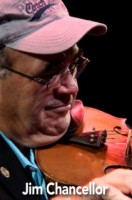 Jim “Texas Shorty” Chancellor is a five-time Texas State Fiddle Champion and NEA National Heritage Fellow. He learned his music from the masters of the Texas style, such as Benny Thomasson, Eck Robertson, Norman and Vernon Solomon, and Major Franklin. Jim was born in 1943 in Dallas County, Texas, the fourth of five kids born to Bessie Lee and James “Jim Houston” Chancellor. In the early years of his musical career (starting at the age of nine), he appeared on radio station KTER, of Terrell, Texas, with his brother – together they were the “Texas Al and Shorty Show,” with Jim playing mandolin. After meeting the great Benny Thomasson, Jim took up the fiddle, and has since won numerous contests, including the Texas State Fiddle Champion, the World’s Championship at Crockett, Texas (six times) and the Grand Masters in Nashville, TN. In June 2004 Jim was named Senior Champion at the National Oldtime Fiddlers Contest in Weiser, Idaho. Jim has earned a place in the Texas Fiddlers Hall of Fame. Jim has taught at many nationally known camps including the Mark O’Connor/Berklee College of Music Summer Strings Program. The National Endowment for the Arts also honored Jim as a 2010 American Heritage Fellow. Jim traveled to Washington D.C. to receive his award at the Smithsonian and to perform. Jim wast the subject of the film “Texas Style“ by Alan Govenar . He also appeared on “To Tell the Truth.” Arts.gov
Jim “Texas Shorty” Chancellor is a five-time Texas State Fiddle Champion and NEA National Heritage Fellow. He learned his music from the masters of the Texas style, such as Benny Thomasson, Eck Robertson, Norman and Vernon Solomon, and Major Franklin. Jim was born in 1943 in Dallas County, Texas, the fourth of five kids born to Bessie Lee and James “Jim Houston” Chancellor. In the early years of his musical career (starting at the age of nine), he appeared on radio station KTER, of Terrell, Texas, with his brother – together they were the “Texas Al and Shorty Show,” with Jim playing mandolin. After meeting the great Benny Thomasson, Jim took up the fiddle, and has since won numerous contests, including the Texas State Fiddle Champion, the World’s Championship at Crockett, Texas (six times) and the Grand Masters in Nashville, TN. In June 2004 Jim was named Senior Champion at the National Oldtime Fiddlers Contest in Weiser, Idaho. Jim has earned a place in the Texas Fiddlers Hall of Fame. Jim has taught at many nationally known camps including the Mark O’Connor/Berklee College of Music Summer Strings Program. The National Endowment for the Arts also honored Jim as a 2010 American Heritage Fellow. Jim traveled to Washington D.C. to receive his award at the Smithsonian and to perform. Jim wast the subject of the film “Texas Style“ by Alan Govenar . He also appeared on “To Tell the Truth.” Arts.gov
JAN RYBERG (guitar) has performed in the North Texas region for more than twenty years. In addition to his busy performing and teaching schedule, he composes and arranges music for solo guitar and his group, The New Music Ensemble. Mr. Ryberg holds a Masters Degree in music from Southern Methodist University and is on the faculty of the Northeast Campus of the Tarrant Community College District. Additionally, he teaches at Richland College, the Renaissance School, and through the Childbloom Guitar Program. JanRyberg.com
ROBERT GOMEZ (guitar, accordion, etc.) is an accomplished musician having studied Cuban guitar under Nelson Gonzales and performed with Cuban music groups. His recent CD “BRAND NEW TOWNS” has garnered rave reviews as one of Denton’s “backyard bands” receiving national and international acclaim! Gomez is a jazz guitarist, multi-talented musician, singer and songwriter based in Denton, Texas.
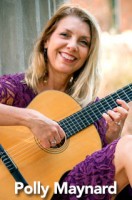 POLLY MAYNARD (guitar) received her Bachelor’s and Master’s degrees in Classical Guitar Performance from UNT, where she taught for 10 years. Her interest in teachong young people about music led her to further her studies. Polly is currently the Director of The Denton Childblooom Guitar Program, a music education program for children. Polly has received numerous teaching commendations for her work with Childbloom, including the coveted “Master Teacher Award”, granted to only one other person in the nation. Many of Polly’s students have gone on to professional careers in music, and the first National Childbloom Guitar Program Scholarship was awarded to one of her students. Polly’s students routinely earn outstanding scores at UIL solo & ensemble guitar competitions throughout their high school careers, and win guitar competitions in college .
POLLY MAYNARD (guitar) received her Bachelor’s and Master’s degrees in Classical Guitar Performance from UNT, where she taught for 10 years. Her interest in teachong young people about music led her to further her studies. Polly is currently the Director of The Denton Childblooom Guitar Program, a music education program for children. Polly has received numerous teaching commendations for her work with Childbloom, including the coveted “Master Teacher Award”, granted to only one other person in the nation. Many of Polly’s students have gone on to professional careers in music, and the first National Childbloom Guitar Program Scholarship was awarded to one of her students. Polly’s students routinely earn outstanding scores at UIL solo & ensemble guitar competitions throughout their high school careers, and win guitar competitions in college .
Polly is a regular performer with area outreach programs, introducing audiences to classical guitar, lute, and other early instruments. These performances are held in schools, senior centers, and special care facilities in the Dallas-Fort Worth area. These ‘informances’ are both entertaining and educational, bringing music to individuals who may have little contact with the arts.
Polly has written several one-woman music/theatre performance pieces including “From Here to Vermeer”; “The Reign in Spain: A Brief History of the Guitar from The Big Twang to the Present”; and “Anon! A Miss! : A History of Women in Music from 1400 – the Present”
She enjoys writing songs, and performing both as a soloist and with “Miss Polly and Her Tiny Big Band”, a favorite group at area festivals.
Polly lives in Denton with her husband and their sweet twin girls. PollyMaynard.com
Guitar in the Schools
Guitar in the Schools
Career Day
Career Day
Career Day Outreach Programs Christopher McGuire will inspire your students with stories of his childhood and how he came to realize he could do, “pretty much anything I saw another human doing as long as I was willing to practice.” Rather than merely showing students how they might become musicians, he shows them how, in our country, they can become anything they are willing to work for. He explains to them, “You are here in school to practice becoming the best you that you can be.” McGuire also includes his now famous group chant: “I’m exercising my brain – to have more FREEDOM!” It’s a celebration of the limitless possibilities of growing up and being educated in the United States of America.
Ragas to Riches
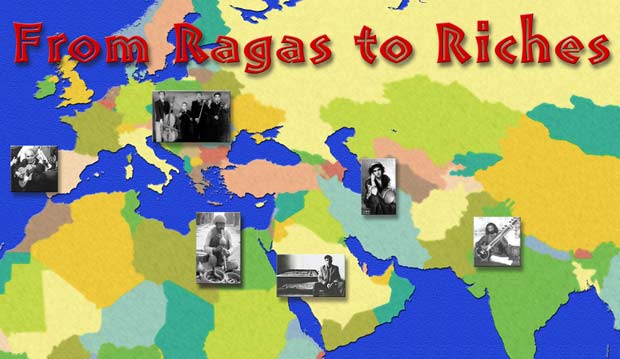
The Allegro Guitar Quartet (AGQ) performs “From Ragas to Riches,” a program for elementary school children that traces the plight of the Gitano (or Rom) people from northern India to Spain. The students hear musical influences the Gypsies carried with them and some they picked up along their way from India to Spain. All at once they receive lessons in music, history, various cultures and geography. We introduce students to the sitar, mandolin, hammered and mountain dulcimers, lute, violin and several kinds of guitars. AGQ performers are Gerald Jones, Polly Maynard, Christopher McGuire and Jan Ryberg.
Our story begins in India with young Roshan playing his Sitar for the Great Raja. Roshan is very skilled at the Sitar. By bending and wiggling the notes of his music he can make his pet snake dance, swaying first this way and then that way. But then comes the Raja’s imperial flute player, Akmed, who says, “No, you’re doing it all wrong.” A musical duel ensues. The snake becomes very confused and upset, jumps from his basket and bites the Raja on the nose. Akmed cries, “The Gypsies have killed the Raja.” Roshan and his family must flee very quickly, leaving all their possessions behind, including Roshan’s beloved Sitar. Thus begins a three hundred year odyssey through Europe and Africa that brings the Gypsies, along with the Arabs and Jews, to Spain where they create the exciting music we call Flamenco!
“From Ragas to Riches” introduces students to the sitar, mandolin, hammered and mountain dulcimers, lute, violin and several kinds of guitars.
Allegro Guitar Quartet
Performers:
Gerald Jones, Polly Maynard, Christopher McGuire, Jan Ryberg
Call or email to have “From Ragas to Riches” in your school or community event.
Texas Tapestry
Texas Tapestry
The Allegro Guitar Series and other Special Events are just the tip of what we do at the Guitar Society. We also perform outreach programs for children in the Fort Worth ISD and in neighboring school districts throughout Tarrant County. We also provide teaching programs at local schools.
“Texas Tapestry, a Musical Journey” traces the influences various groups have brought to Texas over a period of 500 years and the influence Texas musicians are now having on the rest of the world. The historical and geographically rich script was co-written by Madeline Myers and Christopher McGuire. Performers in the program are NEA National Heritage Fellowship Honoree, Jim “Texas Shorty” Chancelor; Winfield Banjo Champion, Gerald Jones; jazz and classical bassist George Anderson and FWCGS Artistic Director, Christopher McGuire.
Join us in continuing to put Fort Worth “On the Map” as one of the premier guitar presenters in North America.
A TEXAS MUSIC TAPESTRY
First performance at Bass Hall, Fort Worth, Texas
| Musicians: Jim “Texas Shorty” Chancellor – fiddle, George Anderson – bass, Gerald Jones – mandolin, Native American flute, banjo, and Christopher McGuire – classical guitar.
Students enter Hall goes dark Reader enters Background music Read poem Before the light dawned on the early morning of man the Maker of all things gave music to the world. Music in the winds and waters whistled through fields and woods, strumming strings of grass, plucking stems and branches making melodies in roaring seas and rhythms in the rivers. The heartbeat of Earth swelled in the seawaves and rolled in rocky streams, … before the humans came. This music of the Earth, man heard and hungered for. He sang songs to answer wind, danced to the drums he made. Wherever man would go he crafted wood and stone to capture the music of his place and time … and hold it in his hands. Good morning/afternoon. That was a poem by Madeline Myers. We’ll hear some more of her poetry later on. Our show “A Texas Music Journey” will take us to faraway places and back here to Texas as we discover just some of the influences that have made Texas music so rich and interesting. Humans probably first came to Texas as early as 40,000 years ago and were hunter – gatherers. Their first instruments were probably drums and then flutes came later. GERALD PLAY FLUTE This is Kiowa “courting” flute song. Show pictures of Plains Indians OUR trip begins with a young Indian girl who lived in the north Texas plains. She was used to hearing the beautiful flute and drum music played as the young braves courted her friends. But the music she heard in her heart was different and she danced to a different drumbeat. STOP FLUTE BEGIN SOFT DRUMMING The name her Kiowa father gave her was Wind Singer, for her voice whispered like the high grasses of the plains, and she moved with the rhythms of the earth in her step. STOP DRUMMING – BEGIN FLUTE (SOFTLY) One windy day Wind Singer heard a strange new melody in the breezes, and she stopped dancing. This music was not for her, and she did not know the lonely song, but it held her there, making her sad, and she sought the source. Then she saw him, a lone Spanish conquistador sitting on a rock, making the music with a reed-flute. His companions, she knew, had left days before. Why had he not followed? In time they learned each other’s words and ways. The Spanish soldier had deserted his company out of sorrow for the native oppression at the hands of los conquistadores; for the sufferings of her people had pierced the heart beneath his armor. He told her his stories. She, in turn, showed him the ways of her people. Wind Singer and the Spanish soldier together made new songs for the land, a land changing as they danced together in their New World. PLAY “CANARIOS” SOLO Explain and tell the title of the previous piece: Based on popular music of the CANARY ISLANDS. Explain hemiola This is the kind of music the Spanish soldier would have heard at home. When he brought it to the New World and it fused with the music he heard here he passed on a tradition to Texas that has goes back for thousands of years. Spanish music, much like Texas music has been influenced by many different cultures. Although Spain is part of Europe, the Moors occupied much of it for 600 years. They had a flourishing culture with great libraries and academies. Middle Eastern, Jewish and Gypsy musicians as well as Europeans influenced their music. Although the first Spaniards came to Texas in 1519 they didn’t settle here until the late 1600s. At that time in Europe, the style of music was what we now call Baroque. “Canarios” was one of the most popular Spanish songs and was played by every imaginable instrument and ensemble. One of the most beautiful examples of the mixtures of culture is “Recuerdos de la Alhambra” PLAY “RECUERDOS” PLAY “ROMANCE” FRANCE The French came here in several ways. Some came through the port of New Orleans. Other came via Canada where they had settled earlier. The CANADIAN FRENCH came to be called Cajuns from the term Acadian. The Acadians were French settlers of eastern Canada who were exiled from their land in the 1750s. The Cajuns are their descendants who settled in Louisiana and southeastern Texas. The music they would have heard in their home land of FRANCE would have been waltzes, gigues, bourees and Allemandes. Composers from most of the advanced European countries wrote in the “French style.” One of the most famous German composers of all time, Johann Sebastian Bach, wrote many suites with French dances as the basic structures for the movements. We’re going to play one of his most interesting pieces, “Boureé” from the “Lute Suite in E minor.” It uses a technique called COUNTERPOINT. In counterpoint we play two or more lines that move in “contrary” motion. That means when the top melody goes up, the bottom line goes down, … like this: PLAY “BOUREE” WALTZES Another form of music that came from Europe and really “caught on” all over the world is the Waltz. PLAY “WALTZ” by Fernando Sor – SOLO BAND ENTER Introduce band Some of the earliest waltzes we know of came from the same period as the “Bouree” and we’re going to play one that Bach composed for his wife, Anna Magdelena. We’ll play it the first time through each section the way it’s written and then we’ll ornament it on the repeats. See if you can hear the difference. PLAY “MINUETTE” by J. S. Bach Feature TEXAS SHORTY Waltzes have come to Texas from many countries and here are a few examples: From the SLOVAKIAN composer Franz Lehar we have the “Merry Widow’s Waltz” (play excerpt) And from MEXICO we have the beautiful “Cielito Lindo” (play excerpt) We can’t leave out the most famous TEXAS waltz “Waltz Across Texas” by Texan, Earnest Tubb (play excerpt) We’ll close the “Waltz” section with one of the most popular CAJUN Waltzes “Jole Blonde” (play once through) JIGS or GUIGES, as they were known in France, were also very popular. This next piece is an English gig called KEMPS GIG We’re going to play it the way musicians might have played it four hundred years ago. They would expand, or lengthen a piece by playing it straight the first time through and then with some improvisation and ornamentation in the following times through. PLAY “KEMPS JIG” Once through straight Guitar Solo Then announce the ensemble version Then announce the ornamented version The Texas counterpart to “KEMPS JIG” is the “CUKOO’S NEST” SCHOTTISHES are very popular in Texas. We’re going to feature Shorty on the most famous one. It’s the “TEXAS SCHOTTISH” POLKAS are, according to some experts, the most popular form of music. Almost every country in the Western Hemisphere has some form of the Polka, a dance that originated in POLAND. This Polka from Mexico is popular in Texas and throughout the world. This is: “JESUCITA EN CHIHUAHUA” SOLO GUITAR SECTION (BAND EXITS) Explain strong Spanish and South Am. influence in Texas music. Play MADRONOS ABOUT GUITARS BAND RETURN We don’t know, but the first stringed instruments were probably invented in Africa and Ur (or Mesopotamia), which is now called Iraq. There are many thousands of different stringed instruments in the world today. Texas now has people from just about every country on the planet and we’ve brought just a few examples of different kinds of plucked string instruments from around the world. SHOW INSTRUMENTS “IS THAT YOUR FOOT” Before we go we want to play one more song, but first: • Let’s hear it for Bach Norwood on bass • And Gerald Jones on fiddle, mandolin • And the legendary Texas fiddler, Jim “Texas Shorty” Chancelor • And Christopher McGuire (Bach’s line) I also want to express my appreciation to Madeline Myers for the beautiful poetry and poetic prose you heard at the beginning of the show. Madeline is a published poet. She teaches English and drama at Lewisville High School. She also wrote this: As the land and its people changed, so did its music. As settlers from every corner of our world bring new melodies crafted from the winds and waters of their faraway homelands, their music blends with the tribal songs and ancient airs of the New Land. Our rich, modern culture is a reflection of the wonderful mix of all the rhythms, ancestral and new, of this brave new world. And now here’s a familiar tune to close the show, but we’re going to play it in ways you’ve probably never thought of hearing it. From England this is “Greensleeves.” PLAY “GREENSLEEVES” Theme – guitar solo Cutting Variation – guitar, mandolin and bass Reggae Variation – everyone 6/8 Jazz waltz Variation – everyone Bluegrass Variation – everyone END copyright 2005 FWCGS |
  |
|
 |
||